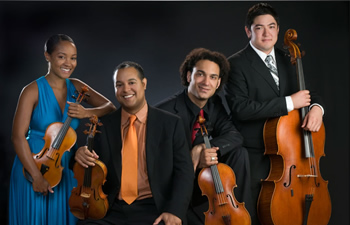The University of North Carolina School of the Arts hosted their own nu Ensemble in Watson Hall with a program comprised entirely of works completed in the last two years. The concert started with a Paul Smadbeck percussion piece, “Rhythm Song.” This piece was originally composed in 1982, but it was arranged by UNCSA student Danté Thomas (who also performed it) for two marimbas and percussion. It was a perfect way to open the program, as Thomas built on the original Smadbeck piece to create an even more expansive, ethereal work of art, drawing the audience in with the music’s trancelike, phasing rhythms.
The nu Ensemble, under the direction of Mark Norman, then performed the world premiere of the first movement of UNCSA composition faculty member Michael Rothkopf‘s Momentum for Chamber Orchestra. This movement is the first of three in total, each inspired by one of Isaac Newton’s three laws of motion – this one being inspired by the first, in which a body in motion remains in motion and a body at rest remains at rest. The piece calls for a number of winds and strings, along with a trumpet, vibraphone, guitar, and piano. I mention the instrumentation specifically because it was fascinating to see how the instruments worked together to evoke the image of a body changing from a body at rest to a body in motion. Within that body, though, each instrument on its own worked as a separate limb or organ, sometimes moving together, sometimes entirely disjointed.
Karen Ní Bhroin conducted the ensemble in a performance of Anna Clyne‘s “Overflow,” a piece written in the beginning of the pandemic when everyone turned to nature for solace. This sentiment is made clear in the music, offering a very natural, airy, even wind-like musical soundscape. Just like in nature, the melodies in this piece arise out of nothing, naturally occurring and shifting unpredictably. The final piece of the concert was a composition by UNCSA student Peter Noll entitled “Sunset Ave.,” under the direction of Tim Heath. Sunset Ave. is not a real place, Noll explained, but instead a fictional place he envisioned based on the feeling of driving around at sunset. Noll’s work encapsulates the escapism of driving, with trancelike melodies similar to the Smadbeck piece. The performance caused me to get lost in the music the same way I get lost in my thoughts driving around at night on an empty street.
The nu Ensemble was formed to create a space where UNCSA students could actively engage with 21st-century music, which is becoming an increasingly important part of “classical” music performance. It is always fascinating to see works like these performed because they allow the audience to experience new instrumentations, harmonies, and performance practices. The audience also gets to witness the active creation of those performance and interpretation practices because the music is newly written. There is also freedom for the performers because they do not necessarily have to worry about following the rules and traditions of, say, Baroque music, allowing them to fully engage with the music itself and create the sound of this generation’s artists. The “airy” sound of Clyne’s piece would not be welcome in a lot of music from previous eras, but it is perfectly suited for this setting. That is what makes groups like the nu Ensemble so compelling and enjoyable, and the future of instrumental music so exciting.












